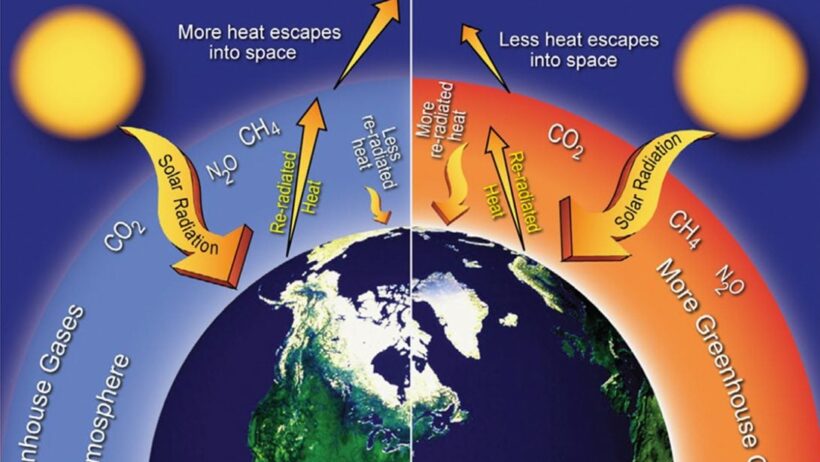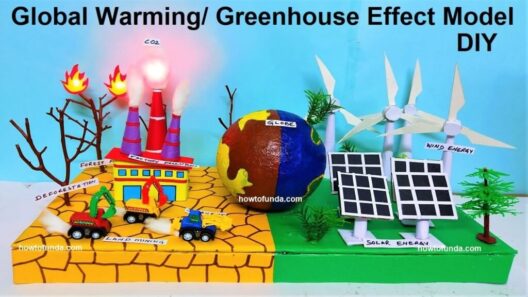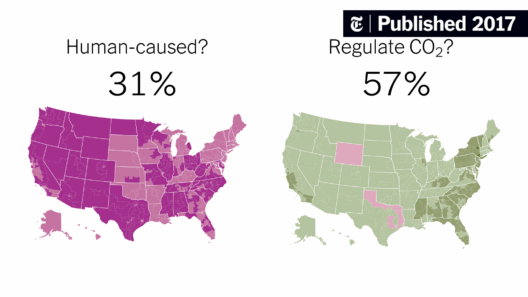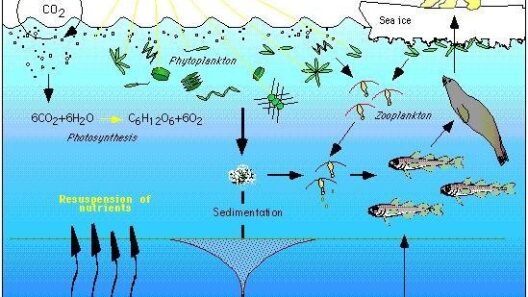To comprehend the labyrinthine dynamics of climate change, one must first traverse the intricate weave of greenhouse gases (GHGs) and their role as the custodians of our planetary temperature. Picture, if you will, Earth as a greenhouse—a colossal transparent dome concealing a fragile ecosystem. Here, sunlight floods in, nurturing life, yet a malevolent culmination of human activity is ensnaring that warmth, leading to a cataclysmic increase in global temperatures.
The phenomenon of global warming is intrinsically linked to the existence of GHGs, including carbon dioxide (CO₂), methane (CH₄), nitrous oxide (N₂O), and other pollutive agents. These gases possess the remarkable ability to absorb infrared radiation, effectively trapping heat within the Earth’s atmosphere. This process can be likened to a warm blanket enveloping a sleeping child; while initially comforting, if that blanket becomes too heavy, it can stifle—resulting in discomfort and, ultimately, detriment.
Understanding the “why” of greenhouse gases requires a deep dive into their origins. Carbon dioxide, the most prominent offender, is predominantly generated through the combustion of fossil fuels—coal, oil, and natural gas, the lifeblood of industrial civilization. When these hydrocarbons burn, they release CO₂ into the atmosphere, where it can linger for centuries. Imagine each molecule of CO₂ as a persistent ghost, haunting the Earth, and contributing to the steady rise in atmospheric temperatures.
On the other end of the spectrum lies methane, an even more potent GHG. Although it is present in smaller quantities, its efficacy in trapping heat is over 25 times that of carbon dioxide over a century. Methane escapes into the atmosphere chiefly from livestock digestion, landfills, and the production of oil and natural gas. Envision methane as a tenacious street performer—capturing attention with a dazzling display of heat retention, yet leaving in its wake a sobering reality of increased warming potential.
Nitrous oxide follows suit, released primarily through agricultural practices—specifically the application of synthetic fertilizers. It is another example of how human activities exacerbate our climate woes. This gas, while less ubiquitous than CO₂ or CH₄, has a staggering global warming potential, estimated to be approximately 298 times greater than that of carbon dioxide over a century. Picture it as a faint whisper that carries immense weight; although not always audible, its impact resonates profoundly through the Earth’s layers.
Amidst this atmospheric turmoil, feedback loops further amplify the challenge. For instance, as temperatures rise, polar ice diminishes, thereby exposing darker ocean waters that absorb more sunlight. This leads to further warming, creating a vicious cycle. An apt metaphor to consider is that of a runaway train: it gathers momentum, and without intervention, its trajectory towards disaster becomes inexorable.
The ramifications of increasing temperatures are manifold and catastrophic. Glaciers melt, sea levels rise, and ecosystems destabilize. Habitats that once flourished are rendered inhospitable; biodiversity, the intricate tapestry woven from myriad species, is increasingly threatened. The coral reefs, often deemed the rainforests of the sea, showcase the fragility of life under warming conditions. As ocean temperatures rise, these reefs undergo bleaching, transforming vibrant ecosystems into stark, desolate landscapes. It is akin to an artist watching their masterpiece fade into obscurity, robbed of color and life.
Moreover, GHG emissions are not solely limited to the atmosphere; they infiltrate the oceans as well, resulting in acidification—another causative factor in marine distress. The oceans, having absorbed roughly a third of the emitted CO₂ from anthropogenic sources, are becoming increasingly corrosive. Shellfish and myriad marine organisms that rely on calcium carbonate for their shells struggle to survive in this new paradigm, hastening declines in marine biodiversity.
Addressing the cause-effect relationship requires a multifaceted approach—both mitigation and adaptation strategies. Transitioning to renewable energy sources such as wind, solar, and hydroelectric power is paramount. It is essential to recalibrate our energy consumption from fossil fuels to sustainable alternatives. This shift positions humanity to forge a path toward a habitable future, akin to steering the aforementioned runaway train back onto a safe track.
Moreover, fostering practices such as reforestation and promoting sustainable agriculture can significantly contribute to the reduction of GHG emissions. Trees act as atmospheric filters, absorbing CO₂ and releasing oxygen back into the environment. This powerful, symbiotic relationship urges us to cherish and protect our forests—nature’s oxygen producers and carbon sinks.
In light of the growing urgency of climate change, it is imperative for individuals and governments alike to understand their role in reducing GHG emissions. The responsibility is shared; a communal endeavor is essential to counteract the alarming trajectory we currently face. Public awareness, education, and legislative action must converge to create a robust response against the looming specter of global warming.
In conclusion, the complexities surrounding greenhouse gases and their contribution to global warming cannot be overstated. They serve as the proverbial double-edged sword—essential to sustaining life yet devastating when allowed to proliferate unchecked. The call to action is clear: it is time to unpack the intricacies of this environmental quandary and embark on a path that prioritizes the health of our planet. The planet requires stewards, not specters—individuals willing to mitigate their impact and foster a sustainable coexistence for generations to come.





